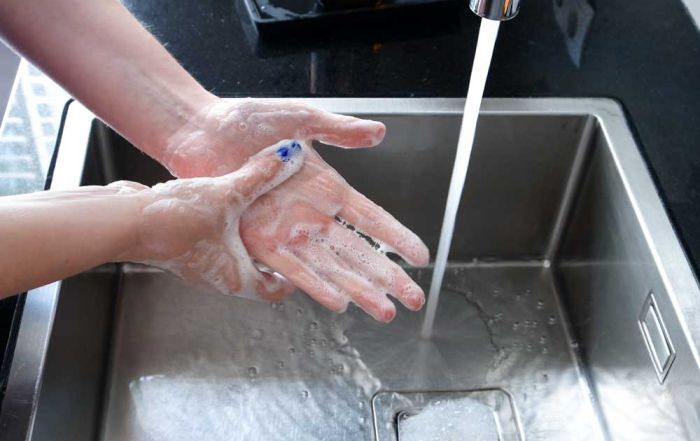Clean Hands, Safe Eats: The Art and Science of Handwashing in Foodservice Operations
Last week, I had the pleasure of joining one of our FoodHandler partners, Martin Bros. Distributing, for a Webinar on handwashing. During the webinar, we got into some of the nuts and bolts, and science, behind washing your hands.
I know this is likely an elementary topic to those of you who live and breathe food safety in the foodservice operations across our country everday, but it really goes beyond a routine task. Handwashing is both an art and a science and plays an extremely important role in preventing foodborne illnesses.
The technique is simple enough. It begins with wetting hands under clean, running water, applying an ample amount of soap, and lathering thoroughly, creating friction by rubbing your hands together, including between fingers and under nails. The soap, doing its job as a surfactant, helps to wash away the dislodged dirt, oils, and microorganisms from your hands. This process should never be just a quick “splash and dash” under running water. It should last for at least 20 seconds and will ensure you are keeping your hands clean and protecting your guests. Last, you should dry your hands with an air dryer, or single-use paper towel, with the single-use towel being my preferred and recommended method to dry your hands.
The art of handwashing, however, extends beyond technique and includes timing. There are those critical points in the food production process where food handlers must wash their hands. These are points I am sure those of you in foodservice could recite in your sleep:
BEFORE:
- beginning food preparation tasks
- handling clean dishes and utensils
- donning a pair of single-use gloves
AFTER:
- using the restroom
- smoking, eating, sneezing, or drinking
- handling raw meat, poultry, or seafood
- touching any part of your hair, face, or clothing/aprons
- handling soiled items (such as trash or cleaning tools)
- handling chemicals
- touching your cell phone or other mobile devices
- removing soiled single-use gloves
- changing tasks
While the art of handwashing focuses on technique and timing, the science behind it delves into microbiology. Our hands are natural reservoirs for bacteria, viruses, and other microorganisms, some of which can cause foodborne illnesses. Proper handwashing disrupts this microbial population, reducing the risk of contamination. Soap and friction are both vital in this process, this is why the recommendation is to scrub your hands for a specified amount of time.
I already mentioned that soap is a surfactant, otherwise known as a surface-active agent. Surfactants are used in a wide range of consumer and industrial products. In short, a surfactant helps to lower the surface tension between two substances and helps to lift dirt and oils from our hands during the washing and rinsing process. Soap also helps to create friction between your hands, which also aids in the removal of these items from the surface of the skin. Thus, I could not emphasize more how important soap is to the handwashing process.
Soap and friction are both vital in this [handwashing] process; this is why the recommendation is to scrub your hands for a specified amount of time.
Is water temperature important? Well, not so much. Friction and soap are key, but the fact is, water temperature isn’t critical. You are unlikely to be able to wash your hands with water hot enough to kill microbes without first scalding your hands. The key is to have a water temperature that is comfortable for employees.
The last step in handwashing is to dry your hands. Now, the food code permits food handlers to dry their hands in one of four ways: (1) individual, disposable towels, (2) a continuous towel system that supplies the user with a clean towel, (3) a heated-air hand drying device, or (4) a hand drying device that employ an air-knife system that delivers a high velocity, pressurized air at ambient temperatures. First, does anyone really use continuous towel systems anymore? But second, of these four methods, the research has continuously noted that the best method to dry hands is by using the individual (single use) disposable towel. Not only is it more effective and efficient in the drying process, it removes more bacteria from the hands (again, the friction is important), and causes less contamination.
Check back later this month for our second blog post for May. I want to expand on our handwashing discussion and discuss why employees don’t wash their hands and some considerations to help improve handwashing compliance. Risk Nothing.
READ MORE POSTS
30 Years Later: The Foodborne Illness Outbreak that Changed Food Safety
In January, we hit a major anniversary. One I am betting snuck by many of you – including me! January marked 30 years since the deadly 1993 E. coli O157:H7 outbreak at Jack in the Box restaurants on the west coast. The anniversary wasn’t on any of the major news networks that I recall. It did make it into a few newspapers, at least one or two of the newspapers that are left. It wasn’t until late-February that I realized it.
Does Temperature Really Matter when Washing your Hands?
In January, I reviewed the changes to the 2022 Food Code in my blog (check out Part I and Part II), and one change to the food code that I had mentioned, but didn’t discuss in-depth, was the change that lowered the water temperature a hand sink was required to produce to 85°F, as noted in Section 2-202.12 of the code. This requirement has been in place since the publishing of the 2001 Food Code, which required a water temperature of 100°F. Prior to this, 110°F was required (see the 1999 Food Code). So why the change and does water temperature when washing your hands really matter?
Hand sinks: Often Taken for Granted, but an Essential Part to Effective Hand Hygiene
Late in January, I received a question about hand sinks in a foodservice operation. The question pertained to school staff (teachers and aides) who were using a hand washing sink in the school kitchen. The question came as a matter of who was allowed access to the kitchen to use the sink, but the question itself caused me to go down a rabbit hole of requirements for hand washing sinks in foodservice operations.
Hot off the Press: The 2022 Model Food Code has been Released! Part Two.
Earlier in the month, we started a discussion about the changes to the 2022 Food Code. If you missed that post, late in December 2022, the Food and Drug Administration released the 2022 Food Code and I wanted to highlight a few of the changes that have been made to the code.










